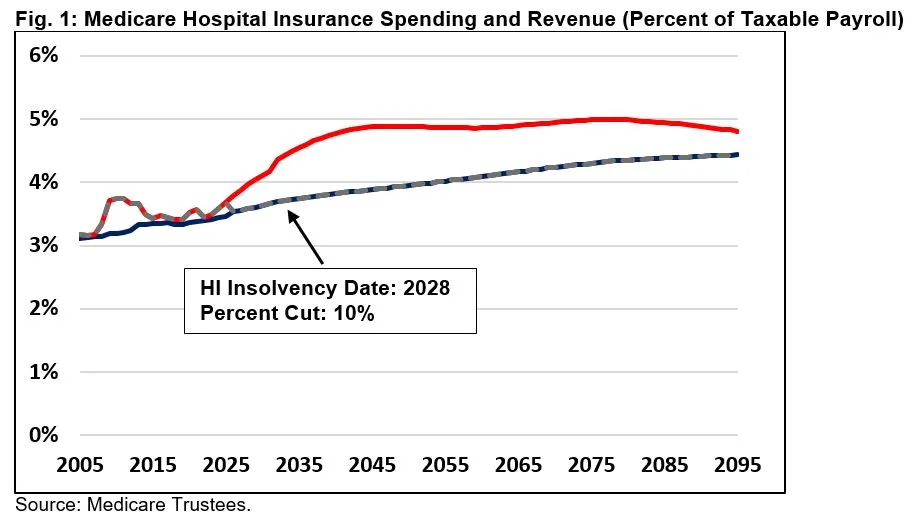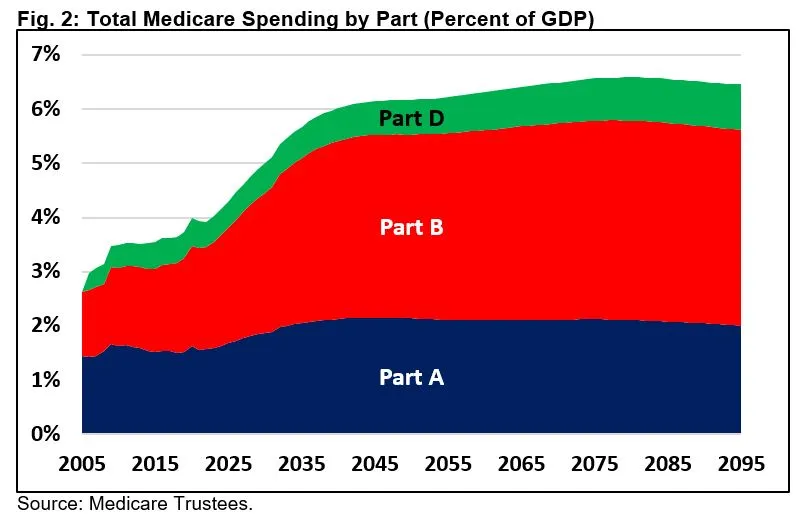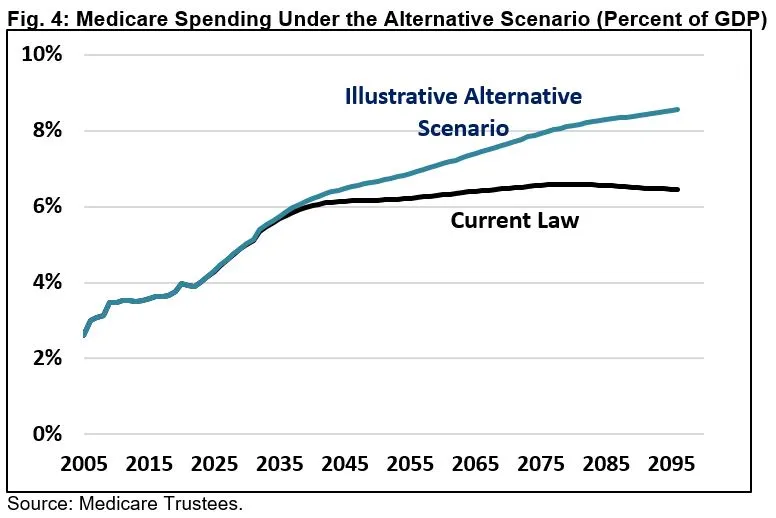Analysis of the 2022 Medicare Trustees' Report
The Social Security and Medicare Trustees released their annual reports on the financial state of those programs and their respective trust funds. The reports update long-term projections based on economic and other developments since their last reports. You can read our analysis of the Social Security Trustees report here.
The Medicare Trustees’ report shows that the Part A Hospital Insurance trust fund will be insolvent in six years, the trust fund faces a 75-year shortfall of 0.7 to 1.6 percent of payroll, and Medicare spending will continue to grow significantly.
Specifically, the Medicare Trustees find that:
- The Hospital Insurance (HI) Trust Fund is Only 6 Years from Insolvency. The Trustees project the trust fund will be insolvent by 2028, just six years from now but two years later than they projected last year.
- The HI Trust Fund Faces a Large Shortfall. The Trustees project that HI will run deficits of $530 billion over the next decade. Over 75 years, they project a shortfall of 0.7 percent of payroll, or 0.3 percent of Gross Domestic Product (GDP). This means that it would take about a 24 percent (0.7 percentage point) increase in the payroll tax rate or a 15 percent spending cut to ensure solvency.
- Total Medicare Spending Is Projected to Grow Rapidly. The Trustees project that gross Medicare spending will grow from 3.9 percent of GDP in 2022 to 6.0 percent by 2040 and stay at roughly 6.5 percent each year from 2070 onward.
- Medicare’s Financial Outlook is Slightly Better Than Last Year’s. The Trustees project a later insolvency date and slight improvement in long-term solvency largely due to higher payroll tax revenue. However, the structural imbalances remain substantial and ultimate costs are similar to last year.
- Medicare’s Finances May Be Much Worse. The Medicare Chief Actuary produces an illustrative alternative scenario that assumes lawmakers update provider payment formulas over time to ensure continued Medicare beneficiary access. Under this scenario, total Medicare spending will grow to 8.6 percent of GDP in 2096 rather than 6.5 percent. The HI shortfall would be 1.6 percent of payroll rather than 0.7 percent of payroll.
The Trustees show that Medicare spending is projected to rise substantially, and the HI trust fund is nearing insolvency. Health savings and trust fund solutions are needed to slow cost growth and ensure Medicare continues to pay full benefits.
The Hospital Insurance Trust Fund Will Be Insolvent in 2028
Medicare Part A, which pays for inpatient hospital services, is financed mostly by a payroll tax through the HI trust fund. Though the trust fund had a balance of $143 billion at the end of 2021, which will increase further this year, it is projected to run cash deficits every year after that until it is exhausted in 2028. At that point, provider and insurer payments would have to be cut by 10 percent (20 percent by 2046) to bring spending in line with revenue.
Beyond 2028, HI faces a significant long-term shortfall. The trust fund will run deficits of $530 billion over the 2023-2032 period, with annual deficits rising from 0.04 percent of taxable payroll in 2022 to 0.66 percent in 2032 and 0.9 percent in 2052 before slowly falling to 0.35 percent by 2096. As a share of GDP, deficits will peak at 0.44 percent in 2045 and total 0.14 percent in 2096.

This imbalance is driven by growing spending due to rising health costs and an aging population. Specifically, HI spending will grow from 3.4 percent of payroll in 2022 to 4.4 percent by 2032 and nearly 5 percent in 2075, falling back to 4.8 percent by 2096. Revenue will grow more modestly from 3.4 percent in 2022 to 3.9 percent by 2045 and nearly 4.5 percent by 2096.
Restoring solvency to the HI trust fund over the next 75 years would require the equivalent of immediately raising the HI payroll tax by 24 percent (0.7 percentage points) or reducing spending by 15 percent. Under the Chief Actuary’s alternative scenario (discussed later), the shortfall and necessary adjustments would be more than twice as large.
Total Medicare Spending Will Grow Significantly
According to the Medicare Trustees, all parts of Medicare – including Parts A, B, and D – will grow rapidly in the coming decades. The Trustees project that gross Medicare spending will grow from 3.9 percent of GDP in 2022 to 5.4 percent in 2032 and 6.2 percent in 2045. After reaching a high of 6.6 percent in 2080, their projection stabilizes and settles at 6.5 percent in 2096.

Medicare Part A, which covers hospital benefits, will grow from 1.6 percent of GDP in 2022 to a high of 2.2 percent in 2045 and then slowly decline to 2 percent by 2095. The Trustees expect Part B (outpatient benefits) and Part D (drug benefits) spending to grow much more quickly. Between 2022 and 2096, they expect Part B to rise from 1.9 to 3.6 percent of GDP and Part D to rise from 0.5 to 0.8 percent of GDP.
This cost growth is driven in part by the rising cost of Medicare Advantage (MA), a private alternative to traditional Medicare that costs modestly more and has had increasing enrollment. As recently as 2010, only 25 percent of Medicare beneficiaries were in MA. By 2026, over half of Medicare enrollees will be in a Medicare Advantage plan. As a result, MA spending, which has already increased from 0.8 percent of GDP in 2010 to 1.6 percent in 2021, is expected to rise to 2.6 percent of GDP by 2031.
This rapidly rising spending underscores the need to reduce Medicare costs. Our Health Savers Initiative has proposed policies to equalize payments across sites of care, reduce Medicare Advantage payments, cap hospital payments, and reduce prescription drug costs. In addition, our ten options to secure the HI trust fund include five options to reduce HI spending specifically and five options to raise HI revenue. Lawmakers would do well to use these options and countless others to slow the growth of Medicare spending and improve its financial status.
Medicare’s Financial Outlook is Slightly Better Than Last Year’s
Overall, Medicare’s financial outlook has slightly improved relative to last year, due a to a combination of factors.
The Trustees now project gross Medicare spending of 6.0 percent of GDP by 2040, less than 0.1 percent lower than last year’s projection. By 2095, they project costs will total 6.5 percent of GDP, almost exactly in line with last year’s projection.
In terms of the HI trust fund, the Trustees this year project the insolvency date will be 2028, two years later than they projected last year. They project the 75-year shortfall will total 0.70 percent of payroll, which is lower than last year’s 0.77 percent of payroll.
Economic changes reduce the 75-year shortfall by 0.06 percent of payroll as the effects of higher inflation and wages and salaries on payroll tax revenue (0.15 percent improvement) outweigh the effect of inflation on provider payments (0.09 percent deterioration). Importantly, the Trustees economic assumptions appear somewhat outdated and thus likely understate inflation and overstate real economic growth.
In addition to economic changes, the Trustees assume more Medicare Advantage spending will come from Part B rather than Part A, reducing the shortfall by 0.07 percent. On the other hand, faster-growing hospital, hospice, and administrative costs increase the shortfall by 0.05 percent, and shifting the 75-year window forward a year increases the shortfall by 0.01 percent.

While total Medicare spending is largely similar to last year’s report, there are compositional changes in this year’s projection. Part B spending is slightly lower in the near term due to higher GDP assumptions and slightly higher over the longer term due to higher hospital outpatient and physician-administered drug spending, while Part D spending is lower throughout due to higher GDP and slower drug price growth, slightly offset by higher enrollment.
Medicare Will Grow More Costly in the Actuary’s Illustrative Alternative Scenario
The Medicare Trustees’ estimates are based on current law, which assumes that laws governing payment rates remain unchanged. However, the Trustees raise questions about payment adequacy over the longer term, as both inpatient hospital payment and physician payments are scheduled to grow more slowly than underlying medical costs.
The Chief Actuary produces an illustrative alternative scenario that assumes the constraints under current law are gradually weakened and some currently scheduled physician bonus payments are continued over the long term. With these assumptions, payments would grow more slowly than the private sector for the next two decades but then grow at about the same rate after.
Under this scenario, spending would grow substantially higher than in the Trustees’ official forecasts, both for the HI trust fund and Medicare spending more broadly.
HI spending would rise from 1.6 percent of GDP in 2021 to 3.0 percent by 2096, as opposed to 2.0 percent under the official projections. As a result, the 75-year shortfall would total about 1.6 percent of payroll and 0.7 percent of GDP, more than double the official projections.

Similarly, Medicare Part B spending would grow from 1.9 percent of GDP in 2021 to 4.7 percent in 2096 (compared to 3.6 percent in 2096 in the official projections).
As a result, total gross Medicare spending grow much faster over the very long term, rising from 3.9 percent of GDP in 2021 to 6.2 percent of GDP in 2040 and 8.6 percent in 2096. Under official projections, by comparison, Medicare spending hovers between 6.0 and 6.5 percent of GDP between 2040 and 2096.
Conclusion
The Medicare Trustees’ report shows the HI trust fund will be insolvent in six years and Medicare spending will rise rapidly as a share of GDP over the next quarter-century. Action is needed soon to constrain the rising costs of Medicare.
It is particularly imperative that lawmakers act sooner rather than later to secure the Medicare HI trust fund by increasing revenues, reducing costs, or some combination. If they do not act, Medicare payments from the trust fund would be abruptly and indiscriminately reduced or delayed, leading to a potential loss of access to care for enrollees.
Many options are available to secure and improve Medicare for future generations, and our Trust Funds Solutions Initiative and Health Savers Initiative will continue to put forward and analyze existing and new ideas to reduce Medicare costs and bring new funding into the program.
Along with the combined Social Security trust funds and the Highway Trust Fund, these three major trust funds are headed for insolvency in the next 13 years. Securing these trust funds would prevent abrupt across-the-board benefits cuts, assure a more sustainable debt path, promote faster economic growth, and provide the opportunity to achieve a number of important policy goals.


